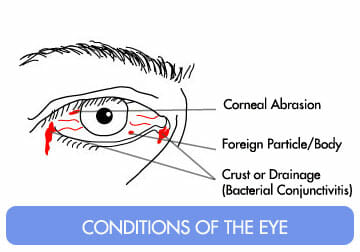Eye Diseases or Conditions Worth Knowing About

Like many other sensitive parts of the body, many diseases and conditions can affect the eye, and subsequently affect a person’s ability to see well. A change in a person’s vision may be the first apparent symptom of a potentially dangerous underlying condition. But, the majority of common eye and vision ailments are readily diagnosed and easily treated. The most common diseases or conditions are as follows.
Refractive Errors
By far the most frequently diagnosed eye problems in the U.S. are refractive errors such as myopia and hyperopia (near-sightedness and farsightedness), astigmatism (distorted vision), and presbyopia (age related near-sightedness). All are by abnormal shape in the lens of the eye, and all are readily corrected by the wearing of corrective lenses, or in some cases, by surgery.
Age-Related Macular Degeneration
Age-related macular degeneration is caused by a physical disturbance to the macula, the center of the retina. AMD typically affects our ability to use our acute vision and our central, or straight-ahead vision. The condition is typically caused by the gradual build up of deposits under the macula, but in a small percentage of cases, can be caused by abnormal blood vessel growth in the macula itself. While there is no cure for AMD at this time, drug and laser therapies have shown some promise in reducing vision loss in AMD patients.
Amblyopia
Better known to the general public as “lazy-eye,” amblyopia is a condition in which one eye develops good vision, and the other one doesn’t. Amblyopia is quite common, as two to three percent of the population experiences it to some degree, and it is easily treated. It is imperative that children and adults experiencing the condition seek treatment as early as possible to prevent long-term negative effects.
Cataracts
Cataracts are the leading cause of blindness, the world over. Typified by a clouding of the lens of the eye, cataracts can occur in people of all ages, and for a variety of reasons. Cataracts are readily treated by surgery.
Glaucoma
Glaucoma is a condition caused by a several different diseases that damage the optic nerve, causing vision loss. While the causes vary according to the disease driving the condition, the results are the same: the pressure of the fluid in the eyes slowly rises, putting more and more pressure on the optic nerve. Without treatment, glaucoma may cause blindness, but if caught early, its effects can be diminished considerably.
[Photo Credit: MedtoGo]

